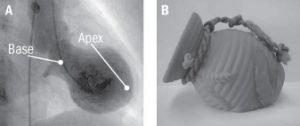A strand from Les Liaisons Dangereuses has the morally righteous Madame de Tourvel seduced by Le Vicomte de Valmont as a bet with his ex-lover La Marquise de Merteuil. Valmont and Tourvel fall deeply and passionately in love. Merteuil is furiously jealous and forces Valmont to reject Tourvel. Tourvel retires, grief-stricken, to a convent. As a result of further devilment, Valmont fights a duel and is mortally wounded. On hearing of the death of the love of her life, Tourvel promptly dies – heartbroken.
[1] That nasty little story was told in 1782, but it was not until 1991 that the rare broken-heart syndrome, “takotsubo cardiomyopathy,” was described as a medical entity in Japan. It was virtually unrecognised in the West until 2005.
[2] A tako-tsubo is a Japanese fisherman’s octopus trap. Sunk at the end of a rope onto the seabed, the narrow-necked sturdy pot is inviting as a place of refuge for the soft mollusc.
When afflicted, the heart adopts the shape of the pot as seen on x-ray or ultrasound images.
Also known as “stress cardiomyopathy”, it occurs mainly in women over 50; only 10% of cases occur in men. 85% of cases are triggered by acutely intense emotional reactions such as grief, fear and anger. Sudden death of a long-term partner, relationship conflicts and severe financial problems are often implicated.
It is thought that a flood of adrenaline in response to severe stress triggers malfunction of the left ventricle, the chamber of the heart which pumps blood around the body. As a result of the significant lack of blood flow, the sufferer complains of serious central chest pain and breathlessness.
Until urgently investigated in hospital, it is not possible to distinguish between the tako-tsubo syndrome and a heart attack. It is vital that the correct diagnosis is promptly made as appropriate treatments differ widely.
To end on a happy note, the broken-heart syndrome is reversible and rarely results in death. The patient usually makes a full recovery after two months of recuperation.
[1] http://www.theartsdesk.com/print/76816
[2] http://www.health.harvard.edu/heart-health/takotsubo-cardiomyopathy-broken-heart-syndrome



